Development
Following the defeat of the Nissan R380-II at the 1967 running of the Japanese Grand Prix, Nissan set about developing an improved car for the 1968 event. Aware of the new CanAm series in North America that ran under the new Group 7 classification, the new R381 became a much more powerful and faster car in comparison to the previous model.
Knowing that the original Prince GR8 Straight-6 would not be powerful enough, Nissan planned to use a new Prince-built V12. However the engines was not completed in time (partially due to this being the first time Nissan or Prince had constructed a V12), so the company turned to a Chevrolet 5.5L V8 which produced nearly 450 hp, twice the amount of the Prince GR8. Also borrowing from CanAm, most notably Chaparral, large rear wings were placed on the new design. These dual wings placed side by side could be driven by hydraulics that moved either the left or right wing up or down in order to increase cornering ability.
For bodywork, the R381 was initially an evolution of the R380's coupe design. The rear tail was lengthened and the engine cover made flat in order to increase rear downforce in conjunction with the rear wing. The back of the car was also made flat, with a Kamm tail effect. However, upon becoming aware of the new Toyota 7 car which also ran in Group 7 rules, Nissan chose to cut the roof of the R381 off. A thin windshield was all that remained, while a tiny rollbar was placed on the engine cover.
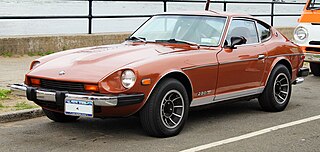
The Nissan Z-car is a sports car which has been manufactured by Nissan Motors Ltd, in six generations, since 1969.

A sports car is a car designed with an emphasis on dynamic performance, such as handling, acceleration, top speed, or thrill of driving. Sports cars originated in Europe in the early 1900s and are currently produced by many manufacturers around the world.

The Nissan Skyline GT-R is a sports car based on the Nissan Skyline range. The first cars named "Skyline GT-R" were produced between 1969 and 1972 under the model code KPGC10, and were successful in Japanese touring car racing events. This model was followed by a brief production run of second-generation cars, under model code KPGC110, in 1973.
Nismo is the in-house tuning, motorsports and performance division of Nissan. Formed in 1984 as a result of a merger of two motorsport departments, Nismo has competed in JSPC, JTCC, the 24 Hours of Le Mans and the 24 Hours of Daytona. They currently participate in the Super GT, the Blancpain GT Series and Formula E.

In automotive design, a RMR or rear mid-engine, rear-wheel-drive layout is one in which the rear wheels are driven by an engine placed just in front of them, behind the passenger compartment. In contrast to the rear-engined RR layout, the center of mass of the engine is in front of the rear axle. This layout is typically chosen for its low moment of inertia and relatively favorable weight distribution. The layout has a tendency toward being heavier in the rear than the front, which allows for best balance to be achieved under braking. However, since there is little weight over the front wheels, under acceleration, the front of the car is prone to lift and cause understeer. Most rear-engine layouts have historically been used in smaller vehicles, because the weight of the engine at the rear has an adverse effect on a larger car's handling, making it 'tail-heavy'. It is felt that the low polar inertia is crucial in selection of this layout. The mid-engined layout also uses up central space, making it impractical for any but two-seater sports cars. However, some microvans use this layout, with a small, low engine beneath the loading area. This makes it possible to move the driver right to the front of the vehicle, thus increasing the loading area at the expense of slightly reduced load depth.

The Nissan 350Z is a two-door, two-seater sports car that was manufactured by Nissan Motor Corporation from 2002 to 2009 and marks the fifth generation of Nissan's Z-car line. The 350Z entered production in 2002 and was sold and marketed as a 2003 model from August 2002. The first year there was only a coupe, as the roadster did not debut until the following year. Initially, the coupe came in Base, Enthusiast, Performance, Touring and Track versions, while the Roadster was limited to Enthusiast and Touring trim levels. The Track trim came with lightweight wheels and Brembo brakes, but its suspension tuning was the same as all other coupes. The Nissan 350Z was succeeded by the 370Z for the 2009 model year.

The Nissan Skyline is a brand of automobile originally produced by the Prince Motor Company starting in 1957, and then by Nissan after the two companies merged in 1967. After the merger, the Skyline and its larger counterpart, the Nissan Gloria, were sold in Japan at dealership sales channels called Nissan Prince Shop.
A mid-engine layout describes the placement of an automobile engine in front of the rear-wheel axles, but behind the rear passenger seats.

The Gloria is a large luxury car made from 1959 by the Prince Motor Company, and later by Nissan Motors since its merger with the former - hence being originally marketed as Prince Gloria and later as Nissan Gloria. Initially based on the smaller Prince Skyline, the Gloria line was merged with Nissan Cedric starting with 1971 models and both continued until 2004, when they were both replaced by Nissan Fuga.
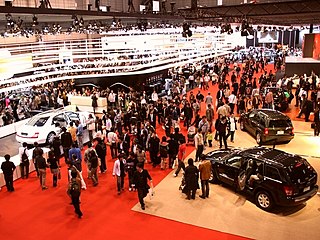
The Tokyo Motor Show (東京モーターショー) is a biennial auto show held in October–November at the Tokyo Big Sight, Tokyo, Japan for cars, motorcycles and commercial vehicles. Hosted by the Japan Automobile Manufacturers Association (JAMA), it is a recognized international show by the Organisation Internationale des Constructeurs d'Automobiles, and normally sees more concept cars than actual production car introductions which is the reason why the auto press see the show as one of the motorshow's big five.

The Nissan R390 GT1 was a racing car built in Atsugi, Japan. It was designed primarily to gain a suitable racing entry in the 24 Hours of Le Mans in 1997 and 1998. It was built to race under the grand touring style rules, requiring a homologated road version to be built. Therefore, the R390 was built originally as road car, then a racing version of the car was developed afterwards. Only one R390 road car was ever built and is stored at Nissan's Zama facility. The road car was claimed to be capable of attaining a top speed of 354 km/h (220 mph). However, this claim has never been proven.

The Nissan GT-R is a high-performance sports car and grand tourer produced by Nissan that was unveiled in 2007. It is the successor to the Skyline GT-R, although no longer part of the Skyline range itself, that name now being used for Nissan's luxury-sport market.
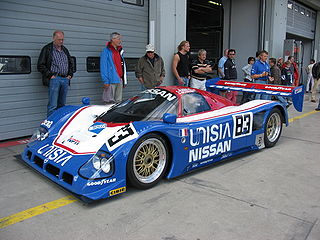
The Nissan R90C was either of two Group C racing cars built in 1990 for Nissan Motors for competition in World Sportscar Championship (WSC) based in Europe and the All Japan Sports Prototype Championship (JSPC). The cars based on the basic R90C platform would compete until 1993 before Nissan chose to withdraw from sports car racing, not returning until 1997. It won three JSPC championships as well as several significant endurance races during its career.
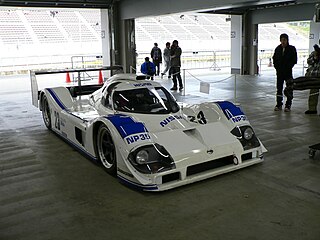
The Nissan P35 was a planned Group C car built by Nissan Motors for competition in the World Sportscar Championship. Developed by Nissan Performance Technology Inc. (NPTI), which had formerly raced under the name Electramotive in the United States, the cars were intended to be completed by the middle of 1992, with competition starting in 1993. However economic troubles for Nissan led to the cancellation of the project soon after testing of the first cars had begun, meaning that the P35s never raced.
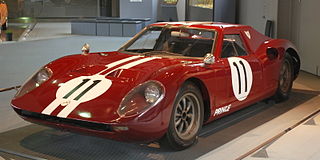
The Prince R380 was a racing car built in 1965 by Prince Motor Company to compete in the Japanese Grand Prix. Following the merger of Prince Motor Company and Nissan Motors in 1966, the R380 was modified into the Nissan R380-II.

The Nissan R382 was a racing car built in 1969 by Nissan Motors for competition in the Japanese Grand Prix. Built to the Group 7 motorsports formula, the car featured Nissan's first V12 engine. It was a replacement for the Nissan R381 from the previous year.

The Nissan R383 was a race car built in 1970 by Nissan Motors that was planned for use in the 1970 Japanese Grand Prix. Replacing the Nissan R382, it would be the final racing sportscar built by Nissan until the mid-1980s.

The Toyota 7 was a series of racing cars developed by Toyota Motor Company in cooperation with Yamaha Motor Corporation. Designed primarily for use in FIA Group 7 competition, it was Toyota's first purpose-built racing car project.

The Nissan Silvia is the name given to the company's long-running line of sport coupes based on the Nissan S platform. Although recent models have shared this chassis with other vehicles produced by Nissan, the name Silvia is interchangeable with the chassis codes. The Nissan Silvia's main competitors worldwide were the Honda Prelude, Mazda MX-6, Toyota Celica, Mitsubishi Eclipse, Isuzu Impulse, and Honda Integra.

Kozo Watanabe is a Japanese automotive engineer who was responsible for the development of the ninth generation Nissan Skyline (R33) and the tenth generation Nissan Skyline (R34).


















